Glossary
Plant Care Library
O
Oak Leaf Ivy
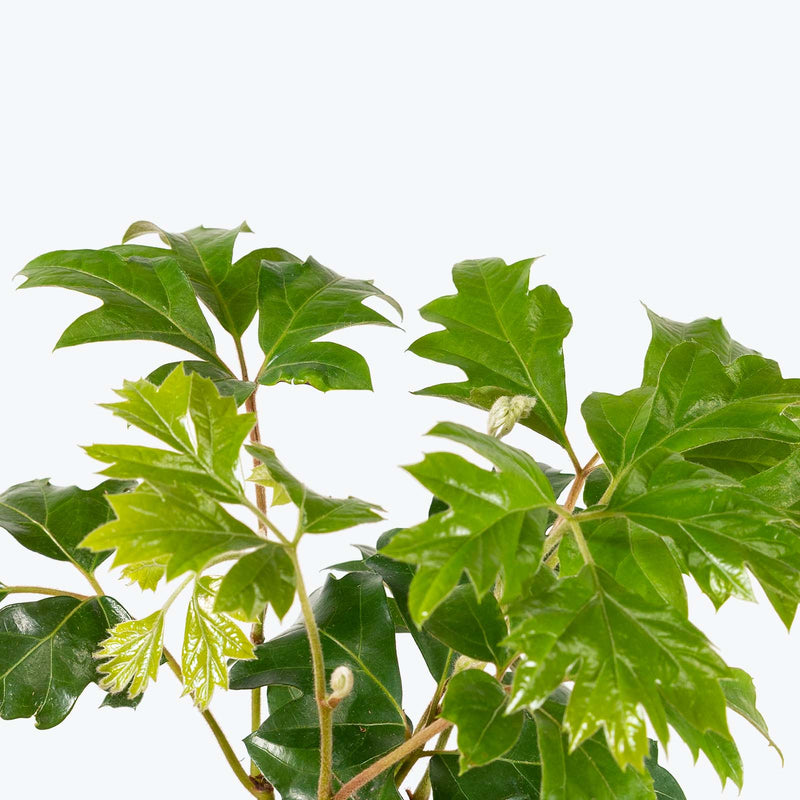
How to care for Oak Leaf Ivy
Oak Leaf Ivy enjoys some direct sun, but they'll also do well in bright, indirect light. It is best to place this plant somewhere where it will receive some nice morning sun, or a couple hours of afternoon sun, and then indirect light the rest of the day.
Oak Leaf Ivy will do well in medium light but will grow faster with brighter light. A good medium-light place in your home would be in the middle of a room that has a regular size window. Remember that plants will grow based on how much light they receive.
Oak Leaf Ivy likes the soil to be relatively dry before the next watering. That usually takes about 2 weeks in an average home environment. It will vary depending on the time of year, your environment and lighting conditions, but for them, it's always safer to underwater or water when you see signs of lack of water (i.e. droopy, floppy, or soft leaves). Expect to water more often in brighter light and less often in lower light.
Oak Leaf Ivy can live in any average home humidity condition and are fairly hardy.
To keep your Oak Leaf Ivy looking full and bushy, feel free to trim long runners and repot them. Use sharp, clean scissors and carefully cut just below a leaf node. Then, remove the leaf at that node and plant that part of the stem. This is where the roots will form.
You can feel comfortable having Oak Leaf Ivy around your home in the potential case where your pet feels like nibbling on it. However, we typically recommend keeping your pets from eating any of your houseplants..
View PlantOlive Tree
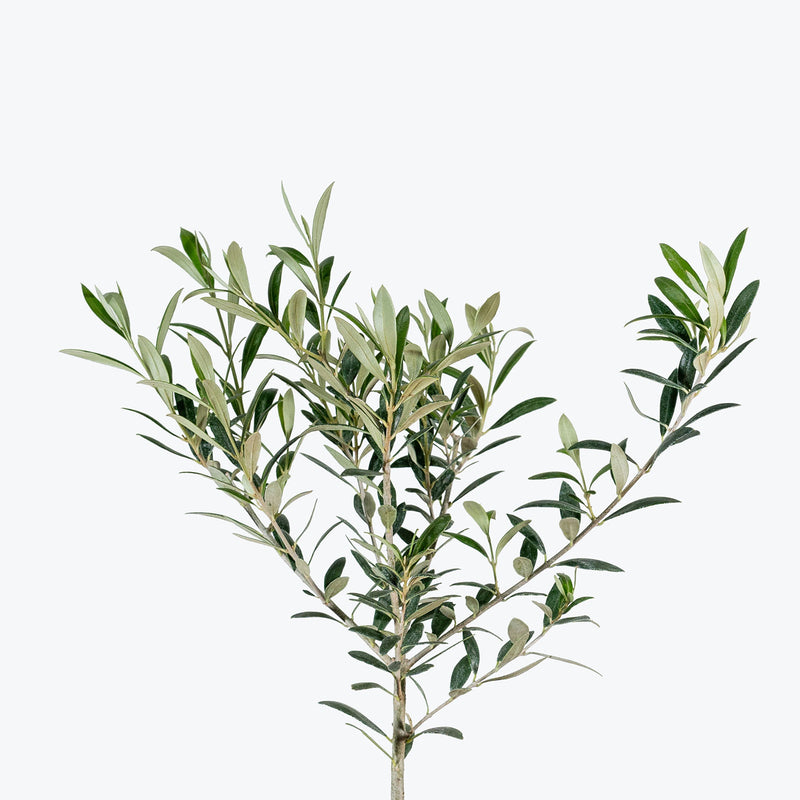
How to care for Olive Tree
Olive Tree loves as much sun as possible. The best spot for them is where they can see the sun during the majority of the day.
Olive Tree will do best in bright light. A nice bright place inside your home would be on the window sill or a stool that is right next to a window, either with or without blinds, depending on if the plant can handle sun. Remember that plants will grow based on how much light they receive.
Olive Tree needs to be watered when the top half of the soil is dry to the touch. That usually takes about 1 week in an average home environment. It will vary depending on the time of year, your environment and lighting conditions, but it's always safer to underwater or give the soil a check before you water again. Expect to water more often in brighter light and less often in lower light.
Olive Tree humidity requirement is low, so do not mist them or put them in a terrarium.
Make sure the soil doesn't dry out completely for too long. Feed the Olive Tree once a month in fall and winter with a balanced houseplant fertilizer. When spring returns, start feeding twice a month, or switch to a slow-release fertilizer. It’s common for them to get scales, the best way to get rid of them is by wiping them off using moist paper towels or Q-tips then spraying them with Isopropyl Alcohol.
Olive Tree is moderately toxic and can cause some adverse reactions when ingested so it is best to not let your pets eat it, which we advise for all plants in general. The severity of the reaction will depend on how much of the plant is ingested but, if you know your pet typically does not eat your plants, this plant will be suitable for your home..
View PlantOrbea Caudata

How to care for Orbea Caudata
Orbea Caudata enjoys some direct sun, but they'll also do well in bright, indirect light. It is best to place this plant somewhere where it will receive some nice morning sun, or a couple hours of afternoon sun, and then indirect light the rest of the day.
Orbea Caudata will do best in bright light. A nice bright place inside your home would be on the window sill or a stool that is right next to a window, either with or without blinds, depending on if the plant can handle sun. Remember that plants will grow based on how much light they receive.
Orbea Caudata likes the soil to be completely dry before the next watering. This can take up to 4 weeks in an average home environment but it will vary depending on the time of year, your environment and lighting conditions. For them, it's always safer to underwater or water when you see signs of lack of water (i.e. wrinkly or soft leaves). Water a little more often in the warmer months.
Their humidity requirement is low, so do not mist Orbea Caudata or put them in a terrarium.
Use a well-draining soil mix specifically designed for cacti and succulents. Fertilize lightly during the growing season with a cactus-specific fertilizer, but avoid over-fertilization which can harm the plant and inhibit flower production. If Orbea Caudata becomes too leggy or spread out, consider pruning to encourage a more compact growth form.
Orbea Caudata is moderately toxic and can cause some adverse reactions when ingested so it is best to not let your pets eat it, which we advise for all plants in general. The severity of the reaction will depend on how much of the plant is ingested but, if you know your pet typically does not eat your plants, this plant will be suitable for your home..
View PlantOrbea Schweinfurthii

How to care for Orbea Schweinfurthii
Orbea Schweinfurthii enjoys some direct sun, but they'll also do well in bright, indirect light. It is best to place this plant somewhere where it will receive some nice morning sun, or a couple hours of afternoon sun, and then indirect light the rest of the day.
Orbea Schweinfurthii will do best in bright light. A nice bright place inside your home would be on the window sill or a stool that is right next to a window, either with or without blinds, depending on if the plant can handle sun. Remember that plants will grow based on how much light they receive.
Orbea Schweinfurthii likes the soil to be completely dry before the next watering. This can take up to 4 weeks in an average home environment but it will vary depending on the time of year, your environment and lighting conditions. For them, it's always safer to underwater or water when you see signs of lack of water (i.e. wrinkly or soft leaves). Water a little more often in the warmer months.
Their humidity requirement is low, so do not mist Orbea Schweinfurthii or put them in a terrarium.
Use a well-draining soil mix formulated for cacti and succulents. Fertilize lightly during the growing season with a cactus-specific fertilizer to support growth and flowering but do not over-fertilize. Orbea Schweinfurthii can be repotted every few years to refresh the soil, but this should be done carefully to avoid damaging the fragile stems.
Orbea Schweinfurthii is moderately toxic and can cause some adverse reactions when ingested so it is best to not let your pets eat it, which we advise for all plants in general. The severity of the reaction will depend on how much of the plant is ingested but, if you know your pet typically does not eat your plants, this plant will be suitable for your home..
View PlantOrchid Cactus
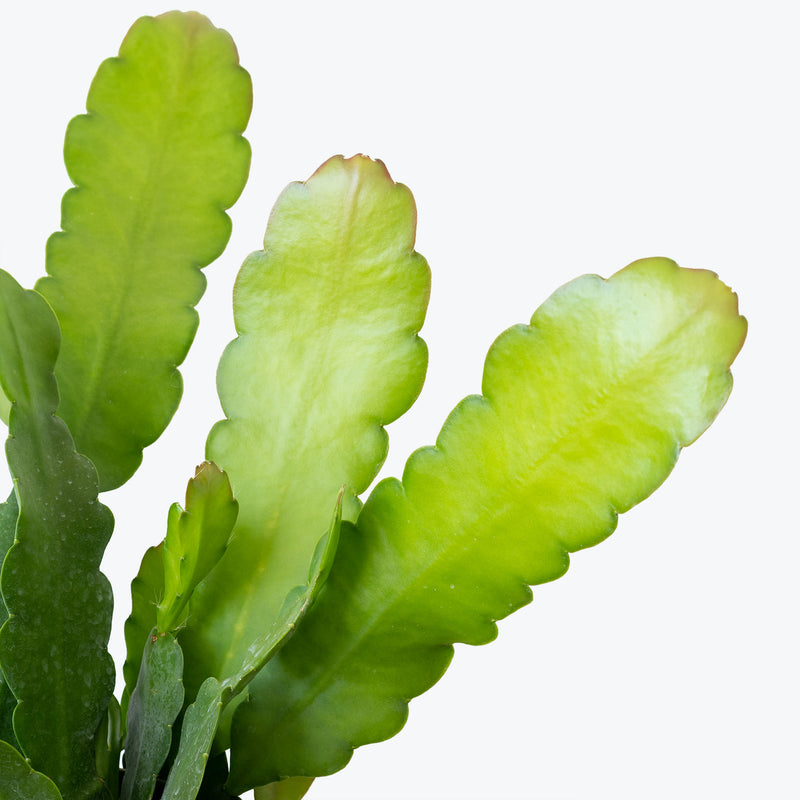
How to care for Orchid Cactus
Orchid Cactus should not be in a position to see the sun directly, although early morning or late evening sun is fine. Filtered sunlight through a sheer curtain is best and most homes are comprised primarily of indirect sunlight. The best spot for them is where they do not see the sun during the majority of the day but still get bright, indirect light.
Orchid Cactus will thrive in bright light, but also can tolerate medium light. A good medium-light place in your home would be in the middle of a room that has a regular size window. They can be placed anywhere between the middle of the room and the window. Remember that plants will grow based on how much light they receive.
Orchid Cactus needs to be watered when the top half of the soil is dry to the touch. That usually takes about 1 week in an average home environment. It will vary depending on the time of year, your environment and lighting conditions, but it's always safer to underwater or give the soil a check before you water again. Expect to water more often in brighter light and less often in lower light.
Orchid Cactus will do well in average humidity environments but will appreciate a little bit of humidity if provided, give them a mist daily or get a humidifier.
To encourage Orchid Cactus blooms, give it a rest over winter, watering sparingly with no fertilizer, then start to feed it every 2 weeks from spring to fall, keeping the soil evenly moist. Once buds appear, keep the plant in the same location as any changes in light or temperature will cause it to drop its buds and flowers. After flowering, trim lightly to shape and manage growth. The long, flat stems are ideal for hanging baskets or mounted displays.
You can feel comfortable having Orchid Cactus around your home in the potential case where your pet feels like nibbling on it. However, we typically recommend keeping your pets from eating any of your houseplants..
Learn MoreView PlantOrchid Cactus Beavertail
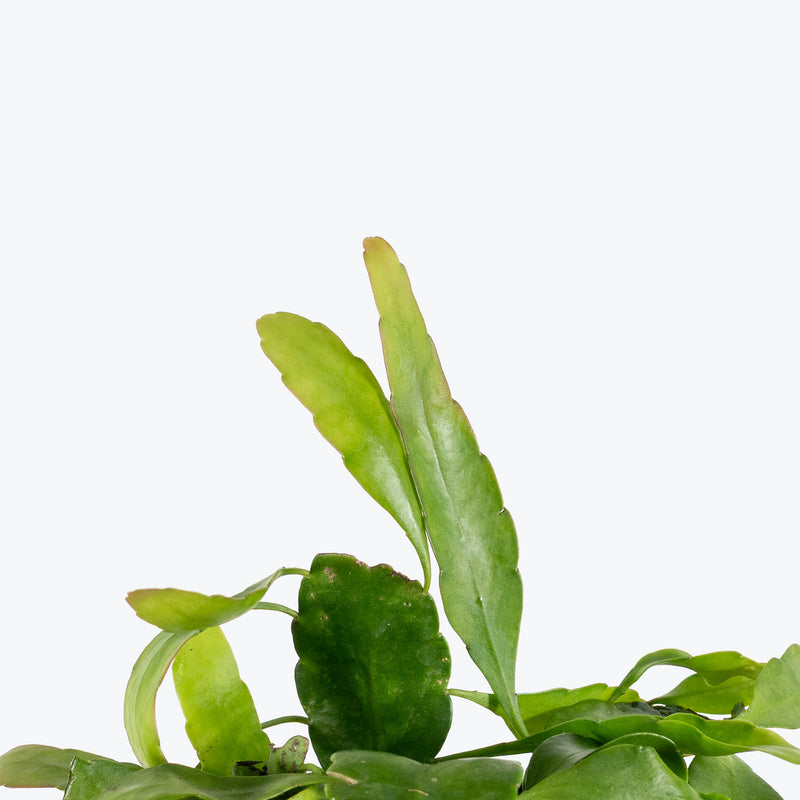
How to care for Orchid Cactus Beavertail
Orchid Cactus Beavertail prefers indirect sunlight, as direct sunlight can cause sunburn or scorching on its leaves. Early morning or late evening sun is acceptable, but filtered sunlight through a sheer curtain is ideal.
Orchid Cactus Beavertail will thrive in bright light, but also can tolerate medium light. A good medium-light place in your home would be in the middle of a room that has a regular size window. They can be placed anywhere between the middle of the room and the window. Remember that plants will grow based on how much light they receive.
Water Orchid Cactus Beavertail when the top half of the soil is dry to the touch. In an average home environment, this typically takes about 1 week. It's always safer to underwater or check the soil before watering again. Expect to water more often in brighter light and less often in lower light.
Orchid Cactus Beavertail will do well in average humidity environments but will appreciate a little extra humidity if provided. Consider misting the plant daily or using a humidifier to create a more comfortable environment.
Use a well-draining cactus mix to support their epiphytic roots. Feed Orchid Cactus Beavertail with a diluted, balanced fertilizer every 4–6 weeks during the growing season. Provide a hanging planter or elevated shelf to let the "tails" trail naturally. With time and care, Epiphyllum 'Beavertail' can reward you with spectacular, orchid-like blooms.
Orchid Cactus Beavertail is moderately toxic and can cause some adverse reactions when ingested so it is best to not let your pets eat it, which we advise for all plants in general. The severity of the reaction will depend on how much of the plant is ingested but, if you know your pet typically does not eat your plants, this plant will be suitable for your home..
Learn MoreView PlantOrchid Cactus Fire
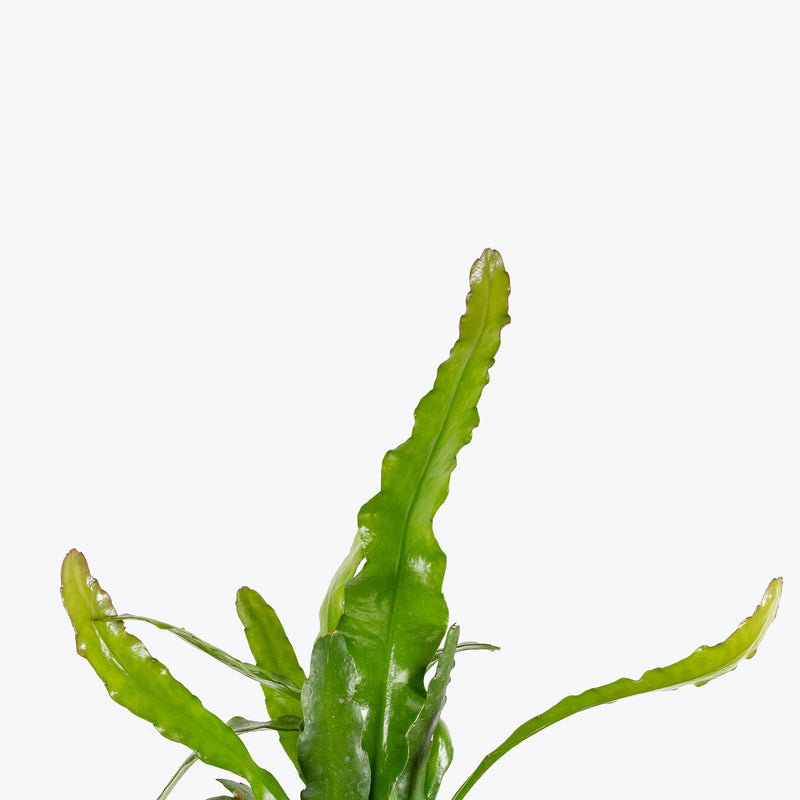
How to care for Orchid Cactus Fire
Orchid Cactus Fire prefers indirect sunlight, as direct sunlight can cause sunburn or scorching on its leaves. Early morning or late evening sun is acceptable, but filtered sunlight through a sheer curtain is ideal.
Orchid Cactus Fire will thrive in bright light, but also can tolerate medium light. A good medium-light place in your home would be in the middle of a room that has a regular size window. They can be placed anywhere between the middle of the room and the window. Remember that plants will grow based on how much light they receive.
Water Orchid Cactus Fire when the top half of the soil is dry to the touch. In an average home environment, this typically takes about 1 week. It's always safer to underwater or check the soil before watering again. Expect to water more often in brighter light and less often in lower light.
Orchid Cactus Fire will do well in average humidity environments but will appreciate a little extra humidity if provided. Consider misting the plant daily or using a humidifier to create a more comfortable environment.
Use a well-draining cactus mix—think orchid bark, perlite, and potting soil. Fertilize Orchid Cactus Fire lightly every 4–6 weeks in the growing season to support both growth and flowering. Encourage trailing growth in hanging baskets or train it to climb a support. Bright light helps maintain vibrant coloration, especially in new shoots.
Orchid Cactus Fire is moderately toxic and can cause some adverse reactions when ingested so it is best to not let your pets eat it, which we advise for all plants in general. The severity of the reaction will depend on how much of the plant is ingested but, if you know your pet typically does not eat your plants, this plant will be suitable for your home..
Learn MoreView PlantOrnamental Pepper
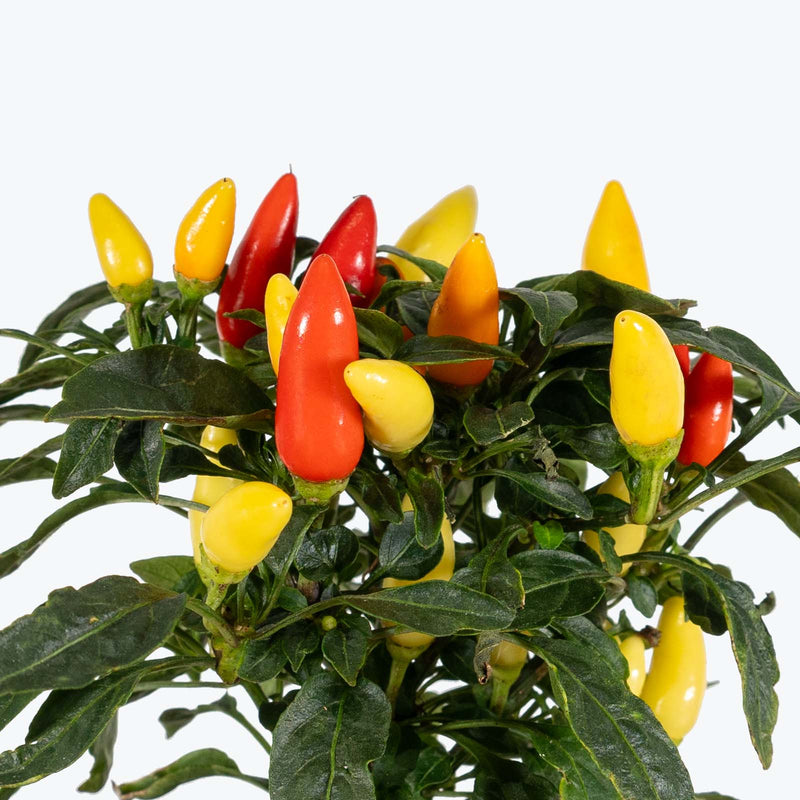
How to care for Ornamental Pepper
They love as much sun as possible. The best spot for them is where they can see the sun during the majority of the day.
They will do best in bright light. A nice bright place inside your home would be on the window sill or a stool that is right next to a window, either with or without blinds, depending on if the plant can handle sun. Remember that plants will grow based on how much light they receive.
Allow the top quarter of the soil to dry before watering again. This usually takes about 3 - 4 days in an average home environment. It will vary depending on the time of year, your environment and lighting conditions. Expect to water more often in brighter light and less often in lower light.
They can live in any average home humidity condition and are fairly hardy.
Though ornamental pepper plants prefer life outdoors, even though they are not frost-tolerant, you can pot them and overwinter them indoors. Keep them warm in well-draining pots that are at least 6 to 8 inches wide if you decide to bring your plants in.
This plant is moderately toxic and can cause some adverse reactions when ingested so it is best to not let your pets eat it, which we advise for all plants in general. The severity of the reaction will depend on how much of the plant is ingested but, if you know your pet typically does not eat your plants, this plant will be suitable for your home..
View PlantOrnamental Pomegranate
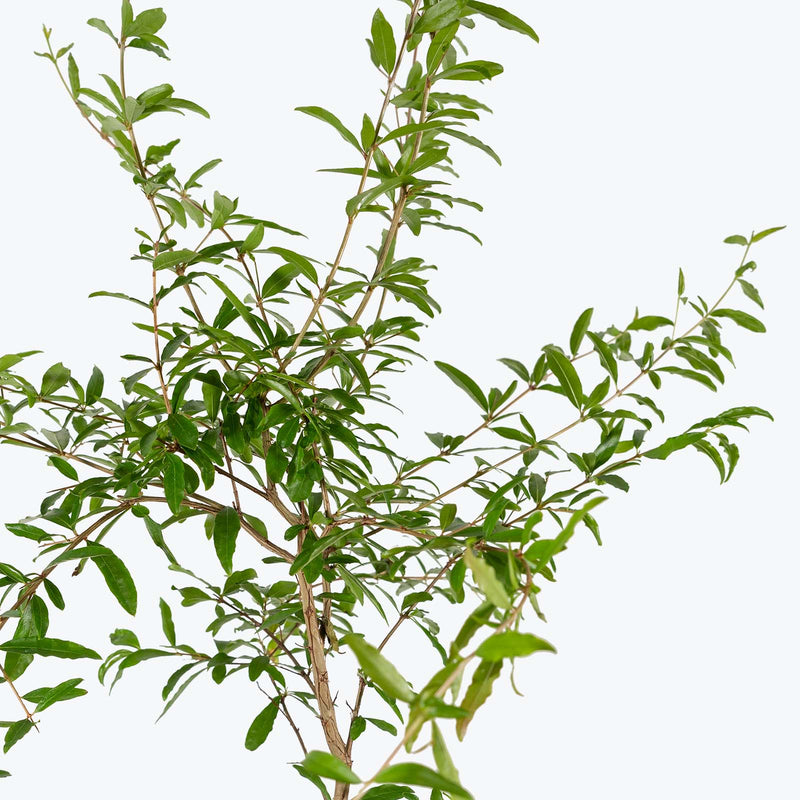
How to care for Ornamental Pomegranate
Ornamental Pomegranate loves as much heat and sun as possible. The best spot for them is outdoors where they can see the sun for the majority of the day (at least 6 hours).
Ornamental Pomegranate will do their best and flower profusely in bright light. A nice bright place outside would be on a sunny balcony, deck, or backyard; inside your home, it would do best in a sunny window sill. Remember that plants will grow and flower based on how much light they receive.
Ornamental Pomegranate needs to be watered when the top half of the soil is dry to the touch. That usually takes about 1 week in an average home environment. It will vary depending on the time of year, your environment and lighting conditions, but it's always safer to underwater or give the soil a check before you water again. Expect to water more often in brighter light and less often in lower light.
Ornamental Pomegranates can adapt to a wide range of humidity levels, although they naturally prefer a relatively dry environment. Avoid creating a consistently damp environment to prevent the risk of root rot.
Ornamental Pomegranates are quite tolerant of various soil types but prefer well-draining soil. In cooler climates, they may lose their leaves in winter but will regrow them in spring. Also, they are resistant to most pests and diseases. While pomegranate fruit is safe for pets to eat in moderation, the plant's leaves, stems, and roots contain potentially harmful toxins if ingested by pets. It's best to keep pets away from this plant.
Ornamental Pomegranate is moderately toxic and can cause some adverse reactions when ingested so it is best to not let your pets eat it, which we advise for all plants in general. The severity of the reaction will depend on how much of the plant is ingested but, if you know your pet typically does not eat your plants, this plant will be suitable for your home..
View PlantOsmanthus Plant
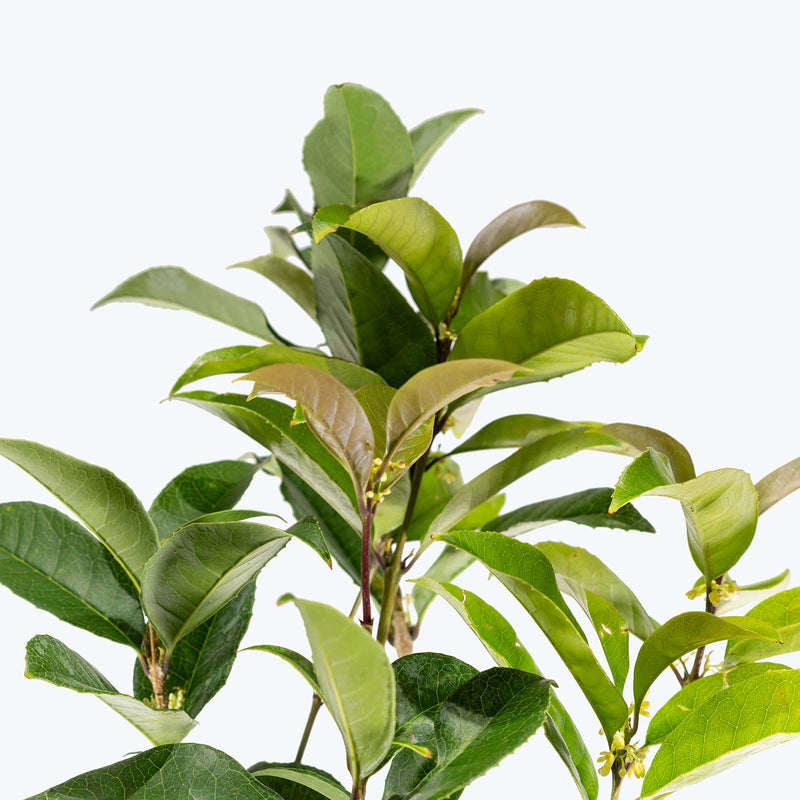
How to care for Osmanthus Plant
Osmanthus Plant enjoys some direct sun, but they'll also do well in bright, indirect light. It is best to place this plant somewhere where it will receive some nice morning sun, or a couple hours of afternoon sun, and then indirect light for the rest of the day.
Osmanthus Plant will do their best and flower profusely in bright light. A nice bright place outside would be on a sunny balcony, deck, or backyard; inside your home, it would do best in a sunny window sill. Remember that plants will grow and flower based on how much light they receive.
Osmanthus Plant needs to be watered when the top half of the soil is dry to the touch. That usually takes about 1 week in an average home environment. It will vary depending on the time of year, your environment and lighting conditions, but it's always safer to underwater or give the soil a check before you water again. Expect to water more often in brighter light and less often in lower light.
Osmanthus Plant will do well in average humidity environments but will appreciate a little bit of humidity if provided, give them a mist daily or get a humidifier.
Fertilize Osmanthus Plant with a balanced liquid fertilizer during the growing season, from spring to early fall. Pruning should be done after flowering to maintain shape and promote bushier growth. This also helps prevent the plant from becoming leggy. Regular pruning and thinning of older branches enhance flower production.
You can feel comfortable having Osmanthus Plant around your home in the potential case where your pet feels like nibbling on it. However, we typically recommend keeping your pets from eating any of your houseplants..
View PlantOxalis Triangularis
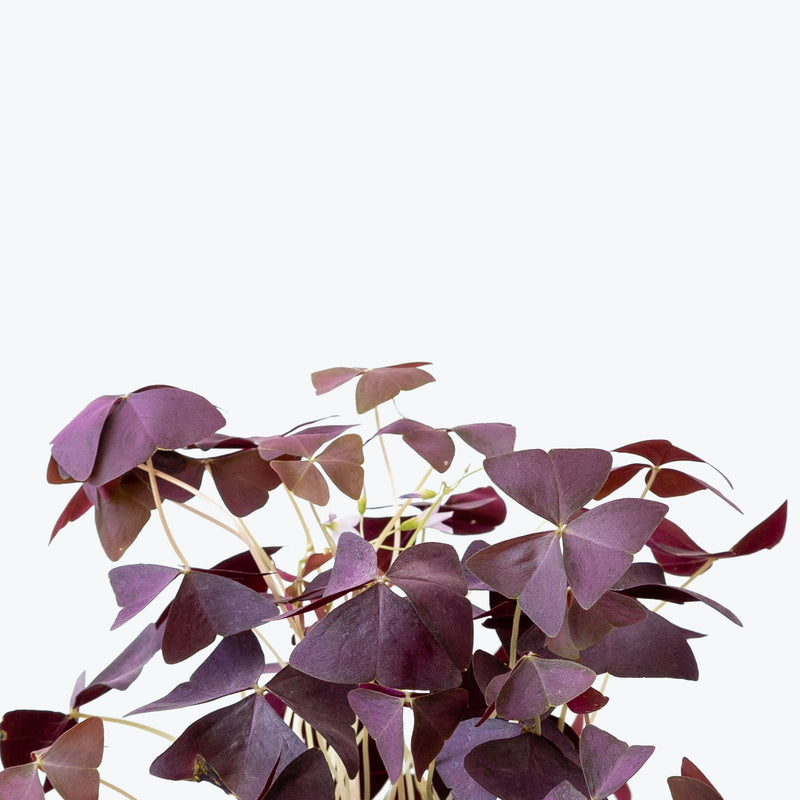
How to care for Oxalis Triangularis
Oxalis Triangularis enjoys some direct sun, but they'll also do well in bright, indirect light. It is best to place this plant somewhere where it will receive some nice morning sun, or a couple hours of afternoon sun, and then indirect light the rest of the day.
Oxalis Triangularis will do best in bright light. A nice bright place inside your home would be on the window sill or a stool that is right next to a window, either with or without blinds, depending on if the plant can handle sun. Remember that plants will grow based on how much light they receive.
Oxalis Triangularis needs to be watered when the top half of the soil is dry to the touch. That usually takes about 1 week in an average home environment. It will vary depending on the time of year, your environment and lighting conditions, but it's always safer to underwater or give the soil a check before you water again. Expect to water more often in brighter light and less often in lower light.
Oxalis Triangularis can live in any average home humidity condition and are fairly hardy.
Periodic pruning of spent flowers and old foliage will encourage new growth and maintain a tidy appearance. During the wintertime, most Oxalis kept as houseplants will go through a semi-dormant phase. They are grown via tubers in the soil, which can be collected and stored in a dark, cool place over the winter and then replant them in the early spring. Come springtime, they’ll bounce right back in all their glory.
Oxalis Triangularis is moderately toxic and can cause some adverse reactions when ingested so it is best to not let your pets eat it, which we advise for all plants in general. The severity of the reaction will depend on how much of the plant is ingested but, if you know your pet typically does not eat your plants, this plant will be suitable for your home..
View Plant



